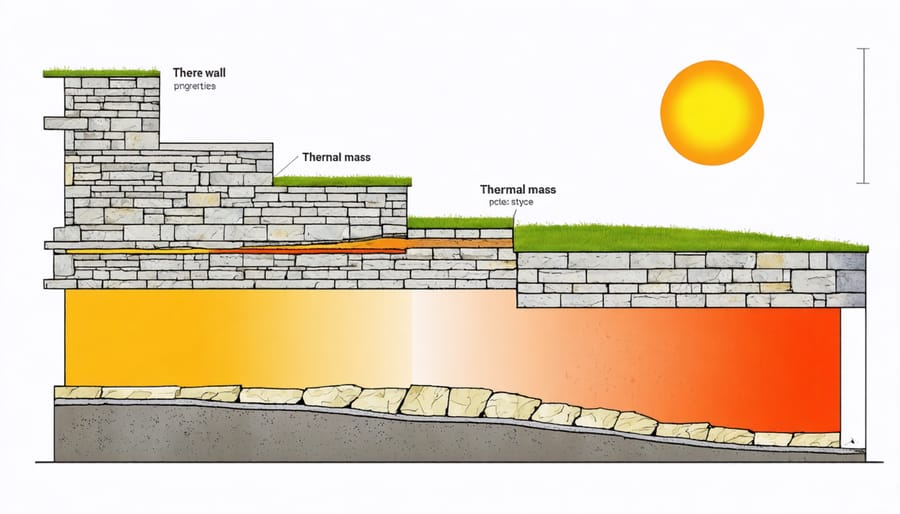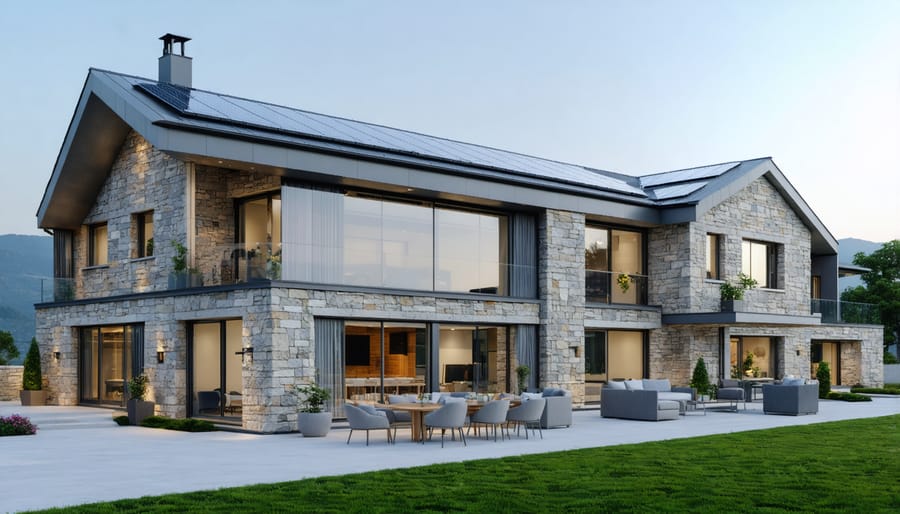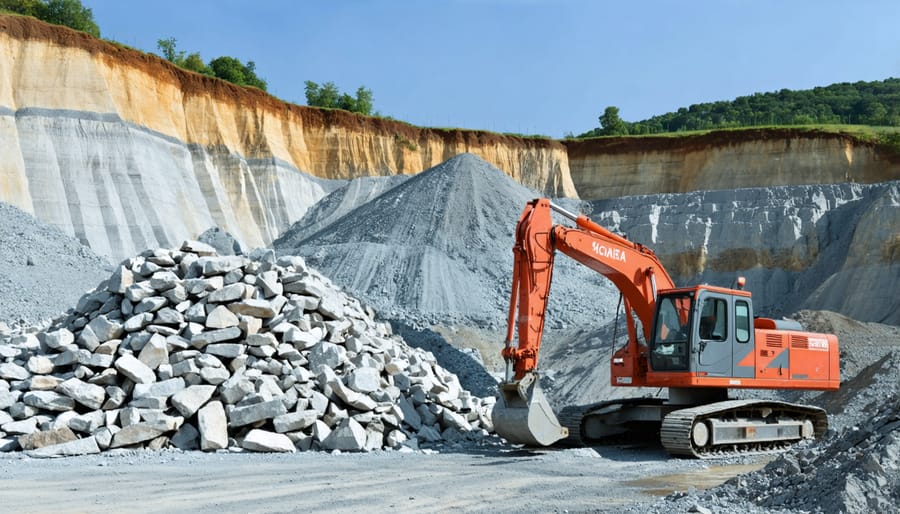Sustainable architectural design revolutionizes how we create buildings that harmonize with our environment while preserving resources for future generations. At its core, this approach integrates modern urban stone architecture with innovative eco-conscious solutions, transforming how we conceptualize and construct our built environment.
By combining time-tested materials like natural stone with cutting-edge technology, sustainable design creates structures that minimize environmental impact while maximizing operational efficiency. These buildings consume less energy, reduce waste, and create healthier spaces for occupants—all while maintaining aesthetic excellence and structural integrity.
Today’s sustainable architecture goes beyond simple green features, embracing a holistic approach that considers a building’s entire lifecycle. From initial material selection to eventual recycling or repurposing, every decision focuses on reducing environmental impact while enhancing human wellbeing. This revolutionary design philosophy doesn’t just create buildings; it shapes a more sustainable future for our cities and communities.
The Core Principles of Sustainable Stone Architecture
Material Lifecycle and Durability
Natural stone stands as a testament to sustainability through its remarkable longevity and minimal environmental impact throughout its lifecycle. Unlike manufactured materials that require frequent replacement, enduring stone construction techniques have proven their worth across millennia. A comprehensive lifecycle assessment of stone reveals its superior durability, with many structures lasting hundreds or even thousands of years with minimal maintenance.
Stone’s durability translates into significant environmental benefits. Its long lifespan reduces the need for replacement materials, cutting down on resource consumption and waste generation. When eventually retired from its primary use, stone can be repurposed, recycled into aggregates, or naturally weathered back into the earth without harmful environmental impacts.
The material requires minimal processing compared to manufactured alternatives, resulting in lower embodied energy. This inherent efficiency, combined with stone’s natural thermal mass properties, contributes to reduced operational energy costs throughout a building’s lifetime. Modern quarrying and fabrication techniques have further improved stone’s sustainability profile, optimizing material use and reducing waste in production.
Energy Efficiency and Thermal Mass
Natural stone’s inherent thermal mass properties make it an excellent choice for sustainable architecture, acting as a natural temperature regulator within buildings. Stone walls and floors absorb heat during warmer periods and release it gradually when temperatures drop, creating a natural heating and cooling cycle that reduces the need for mechanical climate control systems.
This thermal mass effect is particularly effective in climates with significant temperature variations between day and night. During summer, stone’s mass absorbs excess heat, keeping interiors cooler during peak temperatures. In winter, it retains solar heat gained during the day, releasing it slowly to help maintain comfortable indoor temperatures overnight.
The energy conservation benefits are substantial, with studies showing that buildings incorporating stone’s thermal mass can reduce heating and cooling costs by 25-30% compared to conventional construction. This passive temperature regulation not only decreases energy consumption but also reduces the building’s carbon footprint and operational costs over its lifetime.
When properly integrated into building design, stone’s thermal properties contribute to creating more energy-efficient spaces that maintain comfortable temperatures naturally, exemplifying sustainable architectural practices.

Sustainable Stone Sourcing and Processing


Local Sourcing Benefits
Using locally sourced stone in architectural projects delivers multiple sustainability benefits while supporting regional economies. When stone is quarried and processed locally, transportation distances are significantly reduced, resulting in a smaller carbon footprint compared to imported materials. This reduction in shipping distances directly translates to lower fuel consumption and decreased greenhouse gas emissions.
Local stone also naturally harmonizes with the surrounding environment, creating buildings that feel authentically connected to their location. This regional authenticity extends beyond aesthetics – local stone is typically better suited to the area’s climate conditions, having naturally weathered in that environment for millions of years.
The economic impact of local sourcing ripples throughout the community. It creates jobs in local quarries and fabrication facilities, supports regional businesses, and helps preserve traditional stoneworking skills. Additionally, using local stone often results in shorter lead times and more flexible delivery schedules, which can improve project efficiency.
From a lifecycle perspective, locally sourced stone requires less energy for transportation and processing, making it an environmentally responsible choice for sustainable architecture.
Modern Processing Technologies
Modern stone processing has evolved significantly, embracing environmentally conscious practices while maintaining high-quality production standards. Today’s cutting-edge facilities utilize closed-loop water systems that recycle up to 98% of water used in cutting and polishing operations, dramatically reducing water consumption. Advanced CNC machinery optimizes material usage through precise cutting patterns, minimizing waste and maximizing yield from each stone block.
Dust collection systems have also improved substantially, capturing fine particles that would otherwise become airborne pollutants. These collected materials are often repurposed in other industries, such as construction aggregates or soil amendments. Energy-efficient equipment and smart factory management systems help reduce power consumption, while solar panels increasingly power processing facilities.
Many manufacturers now implement digital templating and 3D modeling technology, allowing for more accurate measurements and reduced material waste. This precision, combined with improved recycling programs for stone offcuts and slurry management systems, creates a more sustainable production cycle. These technological advances not only benefit the environment but also contribute to more cost-effective and efficient stone processing operations.
Design Strategies for Sustainable Stone Buildings
Passive Solar Design with Stone
Drawing inspiration from historic stone building practices, modern architects are rediscovering stone’s remarkable thermal properties for sustainable design. Stone’s high thermal mass allows it to absorb heat during the day and release it slowly at night, creating a natural temperature regulation system that reduces the need for artificial heating and cooling.
In passive solar design, strategically placed stone walls and floors act as thermal batteries. During winter, south-facing stone surfaces capture and store solar heat, gradually warming interior spaces. In summer, the same stone elements absorb excess heat, helping maintain comfortable indoor temperatures without energy-intensive air conditioning.
The effectiveness of stone in passive solar design depends on several factors, including thickness, placement, and color. Darker stones typically absorb more solar energy, while lighter stones reflect it. Interior stone features, such as exposed walls or flooring, work best when positioned to receive direct sunlight during winter months.
Modern buildings incorporating these principles often combine stone with other sustainable materials and techniques. For example, a stone feature wall paired with properly sized windows and overhangs can create an efficient passive heating and cooling system that significantly reduces energy consumption while providing natural temperature stability throughout the year.
Water Management and Stone
Natural stone plays a crucial role in sustainable water management systems within architectural design. Its inherent properties make it an excellent material for managing rainwater, reducing runoff, and supporting water conservation efforts. Permeable stone pavers and gravel systems allow water to penetrate the ground naturally, replenishing groundwater supplies while reducing the burden on municipal stormwater systems.
In sustainable architecture, stone is frequently incorporated into bioswales and rain gardens, where it helps filter pollutants from water while creating aesthetically pleasing landscape features. Strategically placed stone retaining walls can direct water flow and prevent erosion, while stone channels and water features can capture and recirculate rainwater for irrigation purposes.
Modern sustainable designs often integrate stone with green roof systems, where it serves multiple functions. Stone ballast helps protect waterproof membranes, provides weight to prevent wind uplift, and creates pathways for water drainage. In courtyard designs, natural stone can be arranged to create subtle grade changes that direct water to collection points or vegetation areas.
Traditional techniques like dry-stack stone walls continue to prove their worth in sustainable water management. These structures allow water to flow through while providing stability and habitat spaces for local wildlife. When combined with modern water-harvesting systems, stone elements can help create self-sustaining landscape designs that require minimal maintenance and support local ecosystem health.
Case Studies in Sustainable Stone Architecture
Several exemplary projects showcase how natural stone contributes to sustainable architecture while creating lasting, beautiful structures. The Jean-Marie Tjibaou Cultural Center in New Caledonia masterfully demonstrates this approach by incorporating local limestone in harmony with traditional building techniques and modern sustainable practices. The center’s design maximizes natural ventilation and thermal mass properties of stone, reducing energy consumption while honoring indigenous architectural traditions.
In Switzerland, the Mountain Museum Messner by Zaha Hadid Architects emerges from its alpine setting using local limestone and innovative engineering. The building’s stone facade naturally regulates interior temperatures and requires minimal maintenance, exemplifying how innovative stone building projects can achieve both sustainability and architectural excellence.
The California Academy of Sciences in San Francisco demonstrates stone’s versatility in green building. Its limestone elements contribute to the building’s LEED Platinum certification through thermal regulation and durability. The stone components are sourced locally, reducing transportation emissions while providing superior insulation properties.
In Melbourne, the Council House 2 building showcases how sandstone elements can be integrated into modern sustainable design. The building’s stone facade features precise positioning to maximize natural light while minimizing heat gain. This thoughtful use of stone, combined with other green technologies, results in a 85% reduction in electricity consumption compared to conventional buildings.
These case studies highlight how stone architecture continues to evolve, combining centuries-old wisdom with modern sustainable practices. The success of these projects demonstrates that natural stone remains a vital material in creating environmentally responsible buildings that stand the test of time while minimizing their ecological footprint.
The future of sustainable stone architecture stands at an exciting crossroads of tradition and innovation. As we face increasing environmental challenges, the integration of natural stone in sustainable design continues to evolve through advanced technologies and creative applications. Modern architects are combining age-old stone construction techniques with cutting-edge sustainable practices, creating buildings that are both environmentally responsible and aesthetically timeless. The growing emphasis on local sourcing, material lifecycle assessment, and energy efficiency suggests that stone will play an even more crucial role in sustainable architecture. With improved quarrying methods, enhanced processing techniques, and innovative reuse strategies, natural stone remains a cornerstone of sustainable building practices, promising a future where architectural beauty and environmental stewardship coexist harmoniously.










